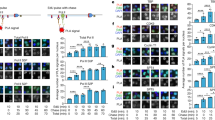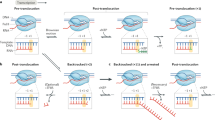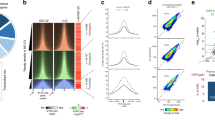Abstract
Transcription through early-elongation checkpoints requires phosphorylation of negative transcription elongation factors (NTEFs) by the cyclin-dependent kinase (CDK) 9. Using CDK9 inhibitors and global run-on sequencing (GRO-seq), we have mapped CDK9 inhibitor–sensitive checkpoints genome wide in human cells. Our data indicate that early-elongation checkpoints are a general feature of RNA polymerase (pol) II–transcribed human genes and occur independently of polymerase stalling. Pol II that has negotiated the early-elongation checkpoint can elongate in the presence of inhibitors but, remarkably, terminates transcription prematurely close to the terminal polyadenylation (poly(A)) site. Our analysis has revealed an unexpected poly(A)-associated elongation checkpoint, which has major implications for the regulation of gene expression. Interestingly, the pattern of modification of the C-terminal domain of pol II terminated at this new checkpoint largely mirrors the pattern normally found downstream of the poly(A) site, thus suggesting common mechanisms of termination.
This is a preview of subscription content, access via your institution
Access options
Subscribe to this journal
Receive 12 print issues and online access
$189.00 per year
only $15.75 per issue
Buy this article
- Purchase on Springer Link
- Instant access to full article PDF
Prices may be subject to local taxes which are calculated during checkout







Similar content being viewed by others
Accession codes
References
Kwak, H. & Lis, J.T. Control of transcriptional elongation. Annu. Rev. Genet. 47, 483–508 (2013).
Yamaguchi, Y., Shibata, H. & Handa, H. Transcription elongation factors DSIF and NELF: promoter-proximal pausing and beyond. Biochim. Biophys. Acta 1829, 98–104 (2013).
Guo, J. & Price, D.H. RNA polymerase II transcription elongation control. Chem. Rev. 113, 8583–8603 (2013).
Egloff, S., Dienstbier, M. & Murphy, S. Updating the RNA polymerase CTD code: adding gene-specific layers. Trends Genet. 28, 333–341 (2012).
Eick, D. & Geyer, M. The RNA polymerase II carboxy-terminal domain (CTD) code. Chem. Rev. 113, 8456–8490 (2013).
Levine, M. Paused RNA polymerase II as a developmental checkpoint. Cell 145, 502–511 (2011).
Shukla, S. et al. CTCF-promoted RNA polymerase II pausing links DNA methylation to splicing. Nature 479, 74–79 (2011).
Chathoth, K.T., Barrass, J.D., Webb, S. & Beggs, J.D. A splicing-dependent transcriptional checkpoint associated with prespliceosome formation. Mol. Cell 53, 779–790 (2014).
Carrillo Oesterreich, F., Bieberstein, N. & Neugebauer, K.M. Pause locally, splice globally. Trends Cell Biol. 21, 328–335 (2011).
Richard, P. & Manley, J.L. Transcription termination by nuclear RNA polymerases. Genes Dev. 23, 1247–1269 (2009).
Kuehner, J.N., Pearson, E.L. & Moore, C. Unravelling the means to an end: RNA polymerase II transcription termination. Nat. Rev. Mol. Cell Biol. 12, 283–294 (2011).
Saponaro, M. et al. RECQL5 controls transcript elongation and suppresses genome instability associated with transcription stress. Cell 157, 1037–1049 (2014).
Jonkers, I., Kwak, H. & Lis, J.T. Genome-wide dynamics of Pol II elongation and its interplay with promoter proximal pausing, chromatin, and exons. eLife 3, e02407 (2014).
Henriques, T. et al. Stable pausing by RNA polymerase II provides an opportunity to target and integrate regulatory signals. Mol. Cell 52, 517–528 (2013).
Mancebo, H.S. et al. P-TEFb kinase is required for HIV Tat transcriptional activation in vivo and in vitro. Genes Dev. 11, 2633–2644 (1997).
Egloff, S., Al-Rawaf, H., O'Reilly, D. & Murphy, S. Chromatin structure is implicated in “late” elongation checkpoints on the U2 snRNA and beta-actin genes. Mol. Cell. Biol. 29, 4002–4013 (2009).
Cheng, B. et al. Functional association of Gdown1 with RNA polymerase II poised on human genes. Mol. Cell 45, 38–50 (2012).
Core, L.J., Waterfall, J.J. & Lis, J.T. Nascent RNA sequencing reveals widespread pausing and divergent initiation at human promoters. Science 322, 1845–1848 (2008).
Flynn, R.A., Almada, A.E., Zamudio, J.R. & Sharp, P.A. Antisense RNA polymerase II divergent transcripts are P-TEFb dependent and substrates for the RNA exosome. Proc. Natl. Acad. Sci. USA 108, 10460–10465 (2011).
Ardehali, M.B. & Lis, J.T. Tracking rates of transcription and splicing in vivo. Nat. Struct. Mol. Biol. 16, 1123–1124 (2009).
Wada, Y. et al. A wave of nascent transcription on activated human genes. Proc. Natl. Acad. Sci. USA 106, 18357–18361 (2009).
Anamika, K., Gyenis, A., Poidevin, L., Poch, O. & Tora, L. RNA polymerase II pausing downstream of core histone genes is different from genes producing polyadenylated transcripts. PLoS ONE 7, e38769 (2012).
Glover-Cutter, K., Kim, S., Espinosa, J. & Bentley, D.L. RNA polymerase II pauses and associates with pre-mRNA processing factors at both ends of genes. Nat. Struct. Mol. Biol. 15, 71–78 (2008).
Bartkowiak, B. et al. CDK12 is a transcription elongation-associated CTD kinase, the metazoan ortholog of yeast Ctk1. Genes Dev. 24, 2303–2316 (2010).
Blazek, D. et al. The Cyclin K/Cdk12 complex maintains genomic stability via regulation of expression of DNA damage response genes. Genes Dev. 25, 2158–2172 (2011).
Davidson, L., Muniz, L. & West, S. 3′ end formation of pre-mRNA and phosphorylation of Ser2 on the RNA polymerase II CTD are reciprocally coupled in human cells. Genes Dev. 28, 342–356 (2014).
Bösken, C.A. et al. The structure and substrate specificity of human Cdk12/Cyclin K. Nat. Commun. 5, 3505 (2014).
Lopez, M.S., Kliegman, J.I. & Shokat, K.M. The logic and design of analog-sensitive kinases and their small molecule inhibitors. Methods Enzymol. 548, 189–213 (2014).
Hintermair, C. et al. Threonine-4 of mammalian RNA polymerase II CTD is targeted by Polo-like kinase 3 and required for transcriptional elongation. EMBO J. 31, 2784–2797 (2012).
Descostes, N. et al. Tyrosine phosphorylation of RNA polymerase II CTD is associated with antisense promoter transcription and active enhancers in mammalian cells. eLife 3, e02105 (2014).
Chan, S., Choi, E.A. & Shi, Y. Pre-mRNA 3′-end processing complex assembly and function. Wiley Interdiscip. Rev. RNA 2, 321–335 (2011).
West, S. & Proudfoot, N.J. Human Pcf11 enhances degradation of RNA polymerase II-associated nascent RNA and transcriptional termination. Nucleic Acids Res. 36, 905–914 (2008).
Zhang, Z. & Gilmour, D.S. Pcf11 is a termination factor in Drosophila that dismantles the elongation complex by bridging the CTD of RNA polymerase II to the nascent transcript. Mol. Cell 21, 65–74 (2006).
Zhang, Z., Fu, J. & Gilmour, D.S. CTD-dependent dismantling of the RNA polymerase II elongation complex by the pre-mRNA 3′-end processing factor, Pcf11. Genes Dev. 19, 1572–1580 (2005).
Li, J. et al. Kinetic competition between elongation rate and binding of NELF controls promoter-proximal pausing. Mol. Cell 50, 711–722 (2013).
Rahl, P.B. et al. c-Myc regulates transcriptional pause release. Cell 141, 432–445 (2010).
Hartzog, G.A. & Fu, J. The Spt4-Spt5 complex: a multi-faceted regulator of transcription elongation. Biochim. Biophys. Acta 1829, 105–115 (2013).
Zhu, W. et al. DSIF contributes to transcriptional activation by DNA-binding activators by preventing pausing during transcription elongation. Nucleic Acids Res. 35, 4064–4075 (2007).
Mayer, A. et al. CTD tyrosine phosphorylation impairs termination factor recruitment to RNA polymerase II. Science 336, 1723–1725 (2012).
Zhang, D.W. et al. Ssu72 phosphatase-dependent erasure of phospho-Ser7 marks on the RNA polymerase II C-terminal domain is essential for viability and transcription termination. J. Biol. Chem. 287, 8541–8551 (2012).
Krishnamurthy, S., He, X., Reyes-Reyes, M., Moore, C. & Hampsey, M. Ssu72 is an RNA polymerase II CTD phosphatase. Mol. Cell 14, 387–394 (2004).
Zhang, Z., Klatt, A., Henderson, A.J. & Gilmour, D.S. Transcription termination factor Pcf11 limits the processivity of Pol II on an HIV provirus to repress gene expression. Genes Dev. 21, 1609–1614 (2007).
Sims, R.J. III., Belotserkovskaya, R. & Reinberg, D. Elongation by RNA polymerase II: the short and long of it. Genes Dev. 18, 2437–2468 (2004).
Lavoie, S.B., Albert, A.L., Handa, H., Vincent, M. & Bensaude, O. The peptidyl-prolyl isomerase Pin1 interacts with hSpt5 phosphorylated by Cdk9. J. Mol. Biol. 312, 675–685 (2001).
Medlin, J. et al. P-TEFb is not an essential elongation factor for the intronless human U2 snRNA and histone H2b genes. EMBO J. 24, 4154–4165 (2005).
Medlin, J.E., Uguen, P., Taylor, A., Bentley, D.L. & Murphy, S. The C-terminal domain of pol II and a DRB-sensitive kinase are required for 3′ processing of U2 snRNA. EMBO J. 22, 925–934 (2003).
Acknowledgements
We thank the High-Throughput Genomics Group at the Wellcome Trust Centre for Human Genetics (funded by Wellcome Trust grant 090532/Z/09/Z and UK Medical Research Council Hub grant G0900747 91070) for the generation of the sequencing data and A. Heger and Computational and Genomic Analysis and Training Programme group members for allowing use of their code repository for the analysis. We also thank P. Cook, C. Norbury and D. O'Reilly for critical reading of the manuscript. This work was supported by Wellcome Trust grants 088542/Z/09/Z and 092483/Z/10/Z and Sir Edward Penley Abraham Trust Fund grants (to S.M.) and a scholarship from the Malaysian Government (to N.F.I.).
Author information
Authors and Affiliations
Contributions
C.L. designed and carried out GRO-seq, ChIP, knockdown and western analysis, produced figures and wrote the manuscript. J.Z. carried out ChIP and western analysis and produced figures. N.F.I. carried out ChIP analysis. J.K. carried out ChIP analyses. M.D. conceived, designed and carried out all bioinformatics analysis, produced figures and wrote the paper. S.M. conceived the project, supervised the analysis, carried out transfection experiments and western blot analysis and wrote the paper.
Corresponding authors
Ethics declarations
Competing interests
The authors declare no competing financial interests.
Integrated supplementary information
Supplementary Figure 1 Validation of CDK9-inhibitor treatment.
(a) Schematic of GAPDH with the middle of the amplicons indicated in base pairs. The transcription start site (TSS) and the terminal polyadenylation site (pA) are marked by arrows, exons by boxes and introns by lines. (b) qRT-PCR analysis of nascent RNA from GAPDH after treatment with KM05283 (KM) and DRB for the indicated time. The nascent RNA level is normalised to the 7SK RNA level. Error bars, s.e.m. (n = 3 biological replicates). (c) Ser2P and Ser5P ChIP levels related to pol II ChIP level (Fig. 1D) on GAPDH performed on HeLa cells untreated (Cont.) or treated with 100 μM KM or DRB. Error bars, s.e.m. (n = 3 biological replicates).
Supplementary Figure 2 GRO-seq read processing and reproducibility.
(a) Distribution of sequenced GRO-seq fragment sizes after pre-processing (elimination of fragments shorter than 20nt). (b) Number of read-pairs for each of the four GRO-seq samples remaining after subsequent processing steps. (c) Number of reads mapped to 5′ETS and 3′ETS of pol I-transcribed 45S pre-rRNA (NR_046235), to the intron of the pol III-transcribed Leucine tRNA gene (Leu74) and to the gene-body of the pol II-transcribed GAPDH protein-coding gene (NM_002046), showing that only pol II transcription is affected by treatment. (d) Ratio of read-counts in these gene segments relative to the control (Cont.) after normalisation to 45S-5′ETS. (e,f) Metagene profile relative to the annotated transcription start site (TSS) (e) and terminal poly adenylation-cleavage sites (pA) (f) in two untreated (Cont.) HeLa samples. Only protein-coding transcripts longer than 5kb are included in this analysis. (g) The high level of correlation between the two repeats in untreated HeLa cells indicates good reproducibility of the GRO-seq procedure. Read counts are integrated in 10kb windows across the genome (Spearman correlation 0.90). (h) Metagene profile (as if each transcript was 10kb in length) of polymerase distribution in untreated HeLa cells with reads from both repeats merged. Notable features: a marked TSS proximal peak both in sense and antisense orientation; a marked sense-only peak downstream of the terminal pA site; depletion of antisense reads within the gene body.
Supplementary Figure 3 TSS-proximal checkpoints.
(a) GRO-seq profile of DHX9 with treatment indicated on the UCSC genome browser. Forward strand reads are noted in blue and reverse strand reads in red here and in subsequent figures. The direction of sense transcription is marked by an arrow. (b) qRT-PCR analysis of pol II ChIP performed on HeLa cells untreated (Cont.) or treated with 100 μM KM or DRB. Error bars, s.e.m. (n = 3 biological replicates). (c) Distribution of the positions of peaks of antisense signal (in 100bp windows) relative to the annotated TSS for each transcript. While for the majority of genes the peak of antisense transcription occurs upstream of the TSS, there is a subset of genes (larger after P-TEFb inhibition) with significant antisense transcription downstream of the TSS.
Supplementary Figure 4 KM and DRB inhibit transcription in the gene bodies without increasing transcription close to the TSSs of EIF2S3 and PLK2.
(a) GRO-seq profiles of PLK2 in untreated (Cont.) and treated (KM, DRB) cells. (b) Top, gene schematic of PLK2. Bottom, qRT-PCR analysis of pol II, Ser5P and Ser2P ChIP performed on HeLa cells untreated (Cont.) or treated with 100 μM KM or DRB and Ser2P and Ser5P relative to the pol II ChIP level. Error bars, s.e.m. (n = 3 biological replicates). (c) Top, gene schematic of EIF2S3. Bottom, qRT-PCR analysis of Ser5P ChIP, Ser2P and Ser5P relative to pol II ChIP level in untreated (Cont.) and treated (KM, DRB) cells. Error bars, s.e.m. (n = 3 biological replicates).
Supplementary Figure 5 CDK9 inhibitors cause premature termination of transcription close to pA sites.
(a) The metagene profile of polymerase distribution in treated (KM, DRB) and untreated (Cont.) cells for transcripts longer than 50kb, shown as if each transcript would be 10kb in length. It demonstrates the signal recovery on long genes and loss of polymerase density downstream of the pA after treatment. (b) GRO-seq coverage of DHX9 with treatment indicated. (c) Top, gene schematic of DHX9. Bottom, qRT-PCR analysis of pol II ChIP and nascent RNA in untreated (Cont.) and treated (KM, DRB) cells. Error bars, s.e.m. (n = 3 biological replicates). (d) Top, gene schematic of KPNB1. Bottom, qRT-PCR analysis of pol II performed on HeLa cells untreated (Cont.) or treated with 1 μM flavopiridol. Error bars, s.e.m. (n = 3 biological replicates). (e) Wild type (WT) and analog-sensitive (AS) CDK9 nucleotide and protein sequences. (f) Western blot analysis of extracts from HEK 293 cells transfected with Myc epitope-tagged CDK9AS and anti-CDK9 shRNA (CDK9sh) and treated or not with 1-NA-PP1 as indicated. Antibodies used are noted on the right. Actin serves as a loading control. (g) Left, Gene schematic of KPNB1. Right, qRT-PCR analysis of pol II ChIP performed on HEK 293 cells untreated (Cont.) or treated with 100 μM KM or 10 μM 1-NA-PP1. Error bars, s.e.m. (n = 3 biological replicates).
Supplementary Figure 6 Effect of KM and DRB on modification of the pol II CTD.
(a) Ratio of qPCR analysis of Ser2P, Ser5P, Ser7P, Thr4P and Tyr1P ChIP to pol II ChIP in untreated (Cont.) and treated (KM, DRB) cells. For the probes pA-0.4, pA+1.4 and pA+2.6 after KM and DRB treatment, the level of pol II is too low to be used and values are only shown for the control sample. (b) qRT-PCR analysis of Ser2P, Ser5P, Ser7P, Tyr1P and Thr4P ChIP in untreated cells. The highest value of each ChIP has been normalised to 1 to facilitate comparison of CTD phosphorylation along KPNB1. (c) Western blot analysis of cell extract after drug treatment, using the indicated antibodies. α-tubulin serves as a loading control.
Supplementary Figure 7 Effect of KM and DRB on recruitment of Pcf11 and Spt5 to KPNB1.
Ratio of qPCR analysis of Pcf11 and Spt5 ChIP to pol II ChIP in untreated (Cont.) and treated (KM, DRB) cells. For probes pA-0.4, pA+1.4 and pA+2.6 after KM and DRB treatment, the levels of factors and pol II are generally very low and ratios are only shown for the control samples and Spt5 related to pol II on probe pA-0.4 after DRB treatment.
Supplementary information
Supplementary Text and Figures
Supplementary Figures 1–7 and Supplementary Table 1 (PDF 1773 kb)
Supplementary Data Set 1
Supplementary Data Set 1 (PDF 217 kb)
Rights and permissions
About this article
Cite this article
Laitem, C., Zaborowska, J., Isa, N. et al. CDK9 inhibitors define elongation checkpoints at both ends of RNA polymerase II–transcribed genes. Nat Struct Mol Biol 22, 396–403 (2015). https://doi.org/10.1038/nsmb.3000
Received:
Accepted:
Published:
Issue Date:
DOI: https://doi.org/10.1038/nsmb.3000
This article is cited by
-
The NELF pausing checkpoint mediates the functional divergence of Cdk9
Nature Communications (2023)
-
Context-specific regulation and function of mRNA alternative polyadenylation
Nature Reviews Molecular Cell Biology (2022)
-
Transcription associated cyclin-dependent kinases as therapeutic targets for prostate cancer
Oncogene (2022)
-
Programmed genomic instability regulates neural transdifferentiation of human brain microvascular pericytes
Genome Biology (2021)
-
Pharmacologic targeting of the P-TEFb complex as a therapeutic strategy for chronic myeloid leukemia
Cell Communication and Signaling (2021)



